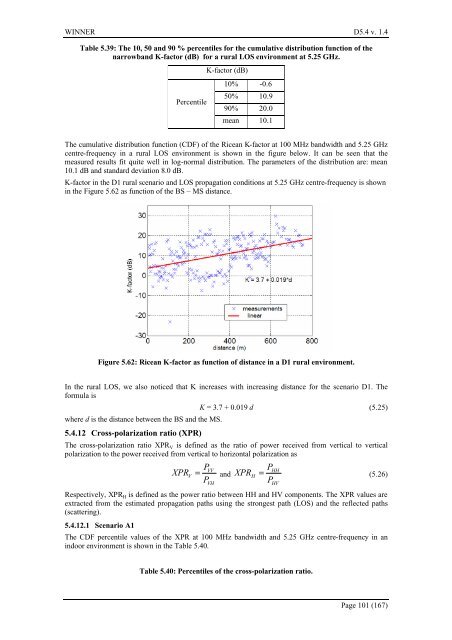Final report on link level and system level channel models - Winner
Final report on link level and system level channel models - Winner
Final report on link level and system level channel models - Winner
You also want an ePaper? Increase the reach of your titles
YUMPU automatically turns print PDFs into web optimized ePapers that Google loves.
WINNER D5.4 v. 1.4<br />
Table 5.39: The 10, 50 <strong>and</strong> 90 % percentiles for the cumulative distributi<strong>on</strong> functi<strong>on</strong> of the<br />
narrowb<strong>and</strong> K-factor (dB) for a rural LOS envir<strong>on</strong>ment at 5.25 GHz.<br />
Percentile<br />
K-factor (dB)<br />
10% -0.6<br />
50% 10.9<br />
90% 20.0<br />
mean 10.1<br />
The cumulative distributi<strong>on</strong> functi<strong>on</strong> (CDF) of the Ricean K-factor at 100 MHz b<strong>and</strong>width <strong>and</strong> 5.25 GHz<br />
centre-frequency in a rural LOS envir<strong>on</strong>ment is shown in the figure below. It can be seen that the<br />
measured results fit quite well in log-normal distributi<strong>on</strong>. The parameters of the distributi<strong>on</strong> are: mean<br />
10.1 dB <strong>and</strong> st<strong>and</strong>ard deviati<strong>on</strong> 8.0 dB.<br />
K-factor in the D1 rural scenario <strong>and</strong> LOS propagati<strong>on</strong> c<strong>on</strong>diti<strong>on</strong>s at 5.25 GHz centre-frequency is shown<br />
in the Figure 5.62 as functi<strong>on</strong> of the BS – MS distance.<br />
Figure 5.62: Ricean K-factor as functi<strong>on</strong> of distance in a D1 rural envir<strong>on</strong>ment.<br />
In the rural LOS, we also noticed that K increases with increasing distance for the scenario D1. The<br />
formula is<br />
where d is the distance between the BS <strong>and</strong> the MS.<br />
5.4.12 Cross-polarizati<strong>on</strong> ratio (XPR)<br />
K = 3.7 + 0.019 d (5.25)<br />
The cross-polarizati<strong>on</strong> ratio XPR V is defined as the ratio of power received from vertical to vertical<br />
polarizati<strong>on</strong> to the power received from vertical to horiz<strong>on</strong>tal polarizati<strong>on</strong> as<br />
P<br />
VV<br />
XPR<br />
V<br />
= <strong>and</strong><br />
PVH<br />
P<br />
HH<br />
XPR<br />
H<br />
= (5.26)<br />
PHV<br />
Respectively, XPR H is defined as the power ratio between HH <strong>and</strong> HV comp<strong>on</strong>ents. The XPR values are<br />
extracted from the estimated propagati<strong>on</strong> paths using the str<strong>on</strong>gest path (LOS) <strong>and</strong> the reflected paths<br />
(scattering).<br />
5.4.12.1 Scenario A1<br />
The CDF percentile values of the XPR at 100 MHz b<strong>and</strong>width <strong>and</strong> 5.25 GHz centre-frequency in an<br />
indoor envir<strong>on</strong>ment is shown in the Table 5.40.<br />
Table 5.40: Percentiles of the cross-polarizati<strong>on</strong> ratio.<br />
Page 101 (167)

















